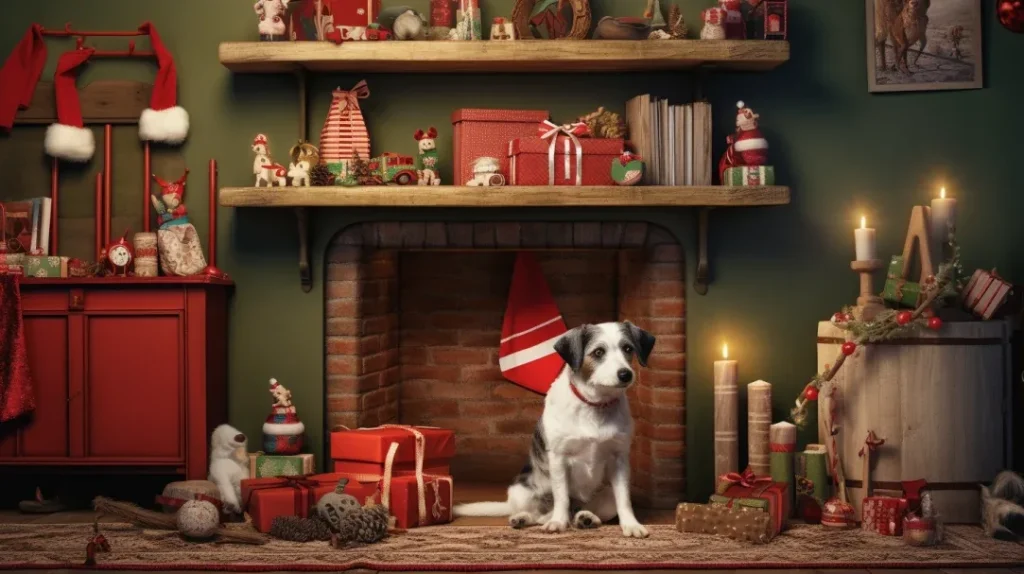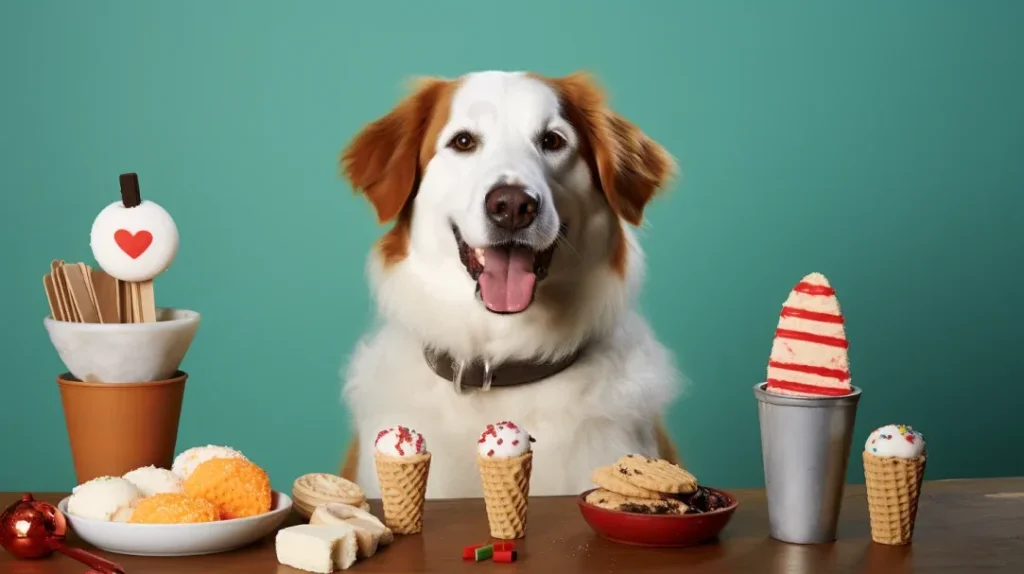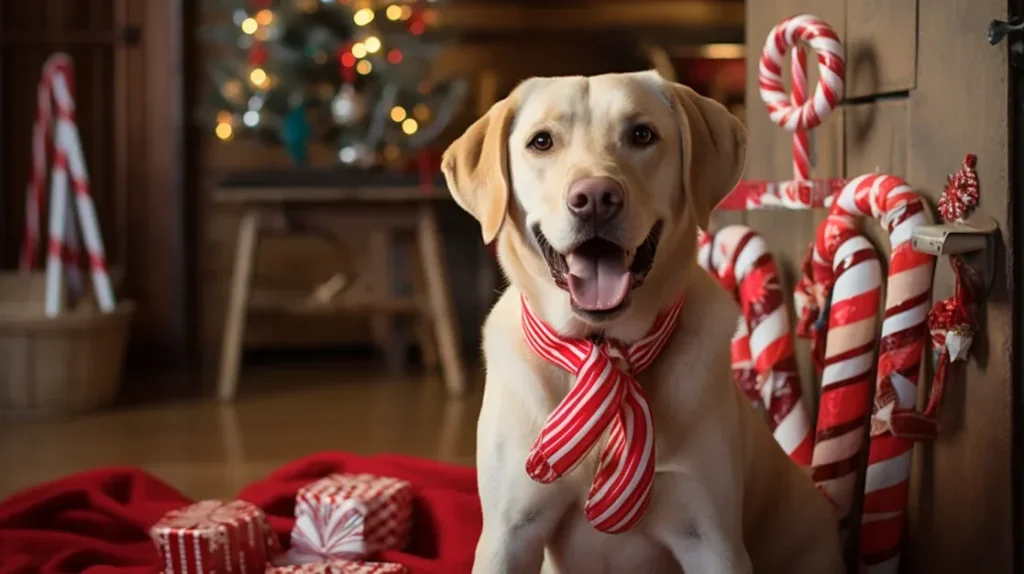Table of Contents
Are you ready to deck the halls with candy canes and holiday cheer? Are candy canes safe for dogs?
Before you let your furry friend join in the festive fun, it’s essential to understand the safety risks involved. Contrary to popular belief, candy canes may not be the best treat for your dog. They can pose serious dangers if consumed.
From harmful ingredients to choking hazards, being knowledgeable and cautious is crucial. Let’s explore the ins and outs of candy cane safety for dogs.
Key Takeaways
- Due to toxic ingredients like xylitol, chocolate, and artificial flavors, candy canes can be dangerous for dogs.
- The rugged texture and shape of candy canes can pose choking hazards, especially for small dogs or those that gulp their food.
- If ingested, plastic wrapping or decorative elements on candy canes can lead to intestinal blockages.
- It is essential to prioritize your dog’s safety by avoiding giving them whole candy canes and opting for alternative, dog-friendly treats.
What Are Candy Canes?

Candy canes are popular sweet treats during the holiday season. These delicious treats are usually made from sugar, corn syrup, and peppermint flavoring. However, when it comes to dogs, pet parents need to be cautious about their safety.
Candy canes are unsafe for dogs, primarily due to their sugar content. Consuming candy canes can lead to upset stomachs and a drop in blood sugar levels for dogs. Moreover, the sharp edges of candy cane wrappers can pose a choking hazard or cause internal injuries if swallowed.
It’s important to note that sugar-free candy cane may contain xylitol, a toxic sugar substitute for dogs. Xylitol can lead to liver damage and acute liver failure in dogs, which can be life-threatening.
If you suspect your dog has consumed a candy canes or its wrapper, it is crucial to seek immediate veterinary care. Symptoms of xylitol poisoning include vomiting, loss of appetite, lack of coordination, and even seizures.
To keep your furry friend safe during the holiday season, it’s best to avoid giving them candy canes or any other human treats. Stick to dog-friendly treats and consult your veterinarian for suitable alternatives.
Types of Candy Canes
There are various types of candy canes available during the holiday season. The most common type is the traditional peppermint candy cane, known for its refreshing and minty flavor. Peppermint candy canes are loved by many, but it’s important to remember that they are not safe for dogs due to their sugar content.
In addition to regular peppermint candy canes, sugar-free candy canes are on the market. However, these sugar-free options may contain xylitol, a toxic substance for dogs. Xylitol can lead to liver damage and acute liver failure in dogs, posing a severe health risk.
To ensure the safety of your furry friend, it’s best to avoid giving any candy cane to dogs. If you suspect your dog has consumed a candy cane, particularly one that contains xylitol, it is crucial to seek immediate veterinary care. Remember your dog’s health during the holiday season, and opt for pet-friendly treats instead.
Safety Concerns for Dogs and Candy Canes
The holiday season brings with it sweet treats and delicious goodies, but when it comes to our furry friends, we need to be cautious about what they consume. Candy canes, a classic holiday favorite, may seem harmless, but dogs have safety concerns regarding these festive treats.
- One of the main issues with candy canes is their high sugar content. Consuming sugary treats can lead to weight gain, upset stomach, and even a drop in blood sugar levels. These symptoms range from a simple stomach upset to more serious conditions like liver failure.
- While regular candy canes may not pose a direct threat to dogs, there is another type of candy cane that pet parents need to be aware of. Sugar-free candy canes often contain a sugar substitute called xylitol. Xylitol is highly toxic to dogs and can cause severe health problems, including acute liver failure.
- What makes xylitol particularly dangerous is its use in various products, including sugar-free gum, mints, and even certain medications. A single candy cane containing xylitol can have enough of this toxic substance to harm a dog.
- If your dog accidentally ingests a candy cane with xylitol, it’s essential to know the symptoms of xylitol poisoning. These can include loss of appetite, vomiting, lack of coordination, and even seizures. If you suspect your dog has ingested xylitol or is displaying any concerning symptoms, it is crucial to seek immediate veterinary care.
- Prevention is always the best approach when it comes to the safety of our furry friends. Keep candy canes and other sweet treats out of reach from your dog, especially if they contain xylitol. Securely dispose of candy cane wrappers and other plastic packaging that could pose a choking hazard.
- Dog-friendly alternatives are available if you still want to treat your canine companion to a peppermint treat this holiday season. You can find specially formulated peppermint candies or dog treats, ensuring their safety and enjoyment.
Remember, the holiday season should be filled with joy and celebration, but it’s essential to be mindful of the potential hazards certain foods can pose to our pets. Understanding the risks associated with candy canes and taking appropriate precautions can ensure a safe and happy holiday season for our four-legged friends.
Potential Harmful Ingredients in Candy Canes for Dogs
You should be aware of the potential risks associated with certain ingredients found in candy canes for dogs. While candy canes may seem like a fun treat to your furry friend during the holiday season, they can pose serious chewing hazards and contain toxic ingredients that can harm dogs.
Many candy canes are made with artificial sweeteners like xylitol, which is toxic to dogs and can cause a dangerous drop in blood sugar levels. Additionally, the hard texture of candy canes can be a choking hazard, especially for small dogs or those prone to gulping their food.
It’s important to carefully read the ingredients list and avoid giving candy canes to your dogs to ensure their safety and well-being.
Moving forward, let’s explore the risks of choking hazards and intestinal blockages that candy canes can pose to dogs.
Choking Hazards and Intestinal Blockage Risks
You must know the choking hazards and intestinal blockage risks that candy canes pose to your dog.
- The rugged texture and shape of candy canes can easily cause choking if your dog tries to swallow them whole.
- Additionally, the plastic wrapping or any decorative elements on the candy cane can cause intestinal blockages if ingested.
It’s essential to take precautions to prevent these incidents and know how to handle them if they occur.
Candy Cane Dangers
Be aware of the potential dangers of candy canes, such as choking hazards and the risk of intestinal blockage. Some candy canes contain xylitol, which is poisonous to dogs and causes hypoglycemia. Small dogs and gulpers can choke on candy canes due to their complexity and brittleness.
To prevent choking incidents, monitoring your dog while they’re enjoying a candy cane treat is essential. Consider breaking the candy cane into smaller pieces or choosing alternative, dog-friendly treats to avoid any potential harm.
Always prioritize your dog’s safety and well-being when giving them treats or snacks.
Preventing Choking Incidents
To prevent choking incidents, always be mindful of potential choking hazards and the risk of intestinal blockage when giving your dog treats like candy canes. Dogs can easily choke on small pieces of candy cane, especially if given the whole cane to chew on. Additionally, the rigid texture of candy canes can increase the risk of intestinal blockage if ingested in large quantities.
To ensure your dog’s safety, follow these tips:
- Supervise your dog when giving them treats, especially if they gulp their food.
- Choose appropriate treats: Opt for treats specifically designed for dogs and easily digestible.
- Cut into small pieces: If you still want to give your dog a candy cane, cut it into small, manageable pieces to minimize the risk of choking.
- Know the signs of choking: Learn dog symptoms and familiarize yourself with first aid techniques to dislodge an obstruction.
- Contact your vet: If you suspect your dog has swallowed a large piece of candy cane or is experiencing any symptoms of intestinal blockage, contact your veterinarian immediately.
Treating Intestinal Blockage
If your dog ingests a large piece of candy cane and shows signs of intestinal blockage, immediately contact your veterinarian for treatment options. Intestinal blockage can be a severe condition that requires prompt medical attention. It occurs when a foreign object, like a candy cane, becomes lodged in your dog’s intestines, preventing the normal flow of food and waste.
This can lead to severe complications, including tissue damage, infection, and death. The best way to avoid accidents like these is to keep candy canes and other small objects out of your dog’s reach. However, if an incident does occur, it’s crucial to seek emergency vet care as soon as possible. The table below highlights common signs of intestinal blockage and the corresponding treatment options.
| Signs of Intestinal Blockage | Treatment Options |
|---|---|
| Vomiting | Surgical removal of the foreign object |
| Loss of appetite | Medications to help pass the object |
| Abdominal pain | Endoscopy to retrieve the object |
The Importance of Supervision and Limiting Access to Candy Canes

Keep an eye on your furry friend and prevent them from getting their paws on candy canes. While candy canes may be a delightful treat, they can pose severe risks to our canine companions. To ensure their safety, it’s crucial to implement practical candy cane training and dog-proof your home.
Here are some essential points to consider:
Candy Cane Training:
- Train your dog to understand that candy canes are off-limits and not meant for consumption.
- Use positive reinforcement techniques, such as rewards and praise, to reinforce good behavior around candy canes.
Dog Proofing the Home:
- Store candy canes in secure containers or cabinets that are inaccessible to your dog.
- Look for any dropped or misplaced candy canes around the house and promptly remove them.
Symptoms to Watch for if Your Dog Consumes a Candy Cane

Be aware of the symptoms that may arise if your dog ingests a candy cane. While candy canes may seem harmless, they pose serious health risks to dogs. If your furry friend has consumed a candy cane, monitoring their behavior and looking out for any signs of distress is essential. Here are some symptoms to watch for:
| Symptoms | Description | Action |
|---|---|---|
| Vomiting | Excessive vomiting may indicate a gastrointestinal blockage. | Contact your vet immediately. |
| Diarrhea | Loose stools or diarrhea can be a sign of digestive upset. | Monitor your dog’s hydration and consult your vet if symptoms worsen. |
| Lethargy | A lack of energy or unusual tiredness can indicate discomfort. | Observe your dog closely and seek veterinary advice if lethargy persists. |
| Abdominal pain | Whining, restlessness, or a hunched posture may suggest abdominal discomfort. | Consult your vet promptly. |
Treat Alternatives: Safe and Delicious Holiday Options for Dogs

Are you looking for safe and delicious holiday options for your furry friend? Homemade dog treats are a great alternative to candy canes, as they can be made with safe ingredients for dogs to consume.
Natural chew toys are another excellent choice, providing entertainment and promoting dental health.
Homemade Dog Treats
Try out these five homemade dog treat recipes for a safe and delicious holiday option for your furry friend. Making your dog treats has several benefits. Firstly, you control the ingredients, ensuring your dog receives a nutritious and wholesome treat. Secondly, homemade treats eliminate the risk of harmful additives or preservatives that may be present in store-bought treats.
Here are two sub-lists to emphasize the benefits of homemade dog treats:
Health Benefits:
- You can incorporate ingredients like pumpkin, sweet potatoes, and carrots packed with vitamins and fiber.
- Homemade treats, such as grain-free or low-fat options, can be tailored to your dog’s specific dietary needs.
Cost Savings:
- Making treats at home can be more affordable in the long run, especially if your dog has dietary restrictions.
- You can freeze larger portions for later use.
Opting for homemade dog treats ensures your dog’s safety and well-being while indulging them in delicious holiday treats.
Now, let’s move on to discuss natural chew toys.
Natural Chew Toys
Give your dog three natural chew toys that are safe and delicious holiday options.
- Natural chew toys have many benefits for your furry friend. They promote dental health by helping to remove plaque and tartar buildup. They also provide mental stimulation and help alleviate boredom.
- Size and durability are crucial when picking a natural chew toy. Ensure it’s appropriate for your dog’s size and chewing strength to avoid choking hazards.
- Look for toys made from natural materials, such as rawhide, deer antlers, or bully sticks. These options aren’t only safe for your dog to chew on but also provide a tasty treat that your dog will love.
Consulting With Your Veterinarian: What to Ask About Candy Canes and Dogs

Before scheduling a consultation with your veterinarian, inquire about the potential risks and safety concerns associated with candy canes and dogs. Consulting with your veterinarian about candy canes and your dog’s health is crucial to ensure the well-being of your furry friend.
During the consultation, you can benefit from the veterinarian’s expertise and knowledge in understanding the potential risks and dangers candy canes pose to dogs. Your veterinarian will be able to provide you with specific information tailored to your dog’s breed, size, and overall health.
It’s important to discuss any pre-existing conditions your dog may have, as specific health issues can increase the risks associated with candy canes.
Educating Others: Spreading Awareness About Candy Cane Safety for Dogs
You can help raise awareness about dog candy cane safety by sharing information with others and encouraging responsible pet ownership. Spreading awareness about the potential dangers of candy canes for dogs is crucial to keeping them safe during the holiday season.
Here are some ways you can help educate others:
- Share articles and information on social media platforms to reach a wider audience.
- Talk to your friends, family, and neighbors about the importance of dog-friendly treats and the risks of giving candy canes to dogs.
- Emphasize the need for pet owners to read ingredient labels and ensure treats are safe for their dogs.
- Recommend alternative dog-friendly treats, such as specially made holiday-themed or homemade treats.
By spreading awareness and educating others, we can ensure all dogs are kept safe and healthy during the holiday season.
Now, let’s move on to the next section about celebrating the holidays with your dog: fun and safe activities to enjoy together.
Celebrating the Holidays With Your Dog: Fun and Safe Activities to Enjoy Together

Many exciting and enjoyable ways to celebrate the holidays with your furry friend exist. It’s important to remember that while including your dog in the festivities can be fun, it’s essential to prioritize their safety and well-being.
One way to celebrate with your dog is by playing fun holiday games together. You can set up a scavenger hunt with treats hidden around the house or play a game of fetch with a holiday-themed toy. Just make sure to choose safe and appropriate toys for your dog’s size and breed.
Another way to get into the holiday spirit is by dressing your dog in holiday-themed costumes. However, it’s crucial to choose outfits that are comfortable, non-restrictive, and don’t pose any safety risks. Always supervise your dog while wearing a costume, and ensure it doesn’t obstruct their movement or breathing.
Frequently Asked Questions
Are Candy Canes Safe For Dogs That Specifically Made for Dogs?
Yes, dogs can eat candy canes explicitly made for dogs. However, being cautious is essential, as regular candy canes can be dangerous for dogs. They may contain ingredients that are toxic to them.
How Can I Prevent My Dog From Getting Into Candy Canes?
To prevent your dog from getting into candy canes, dog-proof your house by keeping them out of reach and storing them in closed containers. To redirect their attention, create a designated dog-friendly area with safe toys and treats.
Are There Any Natural Alternatives to Candy Canes That Are Safe for Dogs?
Are you looking for natural alternatives to candy canes that are safe for dogs? Well, you’re in luck! There are plenty of dog-friendly treats out there that can satisfy your pup’s sweet tooth without any harmful ingredients.
What Training Techniques Can I Use to Teach My Dog to Avoid Candy Canes?
You can use training techniques such as positive reinforcement to teach your dog to avoid candy canes. By rewarding your dog for making the right choices, they will learn to associate candy canes with something negative and choose to avoid them.
Are There Any Specific Activities or Games I Can Do With My Dog During the Holiday Season That Don’t Involve Candy Canes?
During the holiday season, you can enjoy plenty of activities and games with your dog that don’t involve candy canes. Consider using holiday-themed dog toys or setting up a Christmas-themed obstacle course for festive fun.
Conclusion
In conclusion, it’s crucial to prioritize the safety of our furry friends during the holiday season. Candy canes may pose risks to dogs due to harmful ingredients, choking hazards, and potential intestinal blockages. Limiting access and supervising your dog is essential to prevent any mishaps.
If your dog consumes a candy cane, watch for symptoms and consult your veterinarian immediately. Consider safe alternatives and homemade treats to ensure a delightful and worry-free celebration.
Remember, safeguarding your dog’s well-being is as important as protecting a delicate ornament on a Christmas tree.



